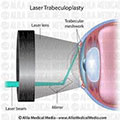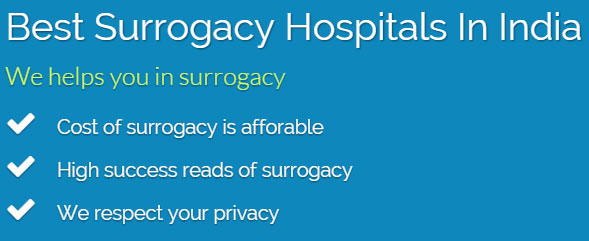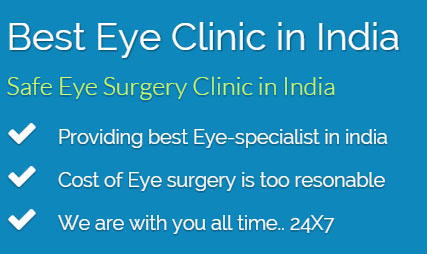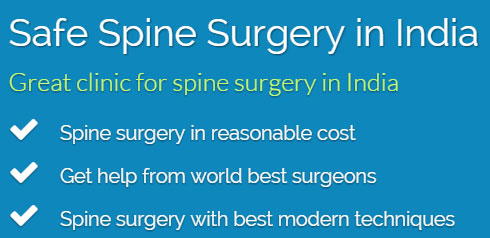Glaucoma Surgery India
 What is Glaucoma ?
What is Glaucoma ?
Glaucoma is a group of diseases that can steal sight without warning or symptoms. Glaucoma is a disease caused by increased intraocular pressure (IOP) resulting either from a malformation or malfunction of the eye's drainage structures. Left untreated, an elevated IOP causes irreversible damage the optic nerve and retinal fibers resulting in a progressive, permanent loss of vision.
The most common form of glaucoma, primary open-angle glaucoma, is associated with an increase in the fluid pressure inside the eye. This increase in pressure may cause progressive damage to the optic nerve and loss of nerve fibers. Vision loss may result. Advanced glaucoma may even cause blindness. Not everyone with high eye pressure will develop glaucoma, and many people with normal eye pressure will develop glaucoma. When the pressure inside an eye is too high for that particular optic nerve, whatever that pressure measurement may be, glaucoma will develop.
India Hospital Tour assists you to search best hospital in India for glaucoma surgery. If you need best glaucoma surgery India, contact to we care India health services that gives you low cost of glaucoma surgery in India. Glaucoma filtration surgery now available in India in best cost.
Causes of Glaucoma
 High level of stress - has been implicated as a major cause of chronic glaucoma, Nutritional Deficiencies and Poor Digestion, Family History of Glaucoma, Being African-American (glaucoma is the leading cause of blindness among this population), Extreme nearsightedness or farsightedness (higher level and a risk of angle closure), Steroid use
High level of stress - has been implicated as a major cause of chronic glaucoma, Nutritional Deficiencies and Poor Digestion, Family History of Glaucoma, Being African-American (glaucoma is the leading cause of blindness among this population), Extreme nearsightedness or farsightedness (higher level and a risk of angle closure), Steroid use
Risk factors for glaucoma include :
People over age 60 are at increased risk for the disease. For African Americans, however, the increase in risk begins after age 40. The risk of developing glaucoma increases slightly with each year of age
African Americans are significantly more likely to get glaucoma than are Caucasians, and they are much more likely to suffer permanent vision loss as a result. People of Asian descent are at higher risk of angle-closure glaucoma and those of Japanese descent are more prone to low-tension glaucoma
Having a family history of glaucoma increases the risk of developing glaucoma
Some studies indicate that diabetes may increases the risk of developing glaucoma, as do high blood pressure and heart disease.
Severe trauma, such as being hit in the eye, can result in immediate increased eye pressure and future increases in pressure due to internal damage. Injury can also dislocate the lens, closing the drainage angle, and increasing pressure
Eye anatomy, namely corneal thickness and optic nerve appearance indicate risk for development of glaucoma. Conditions such as retinal detachment, eye tumors, and eye inflammations may also induce glaucoma. Some studies suggest that high amounts of nearsightedness may also be a risk factor for the development of glaucoma
Using corticosteroids for prolonged periods of time appears to put some people at risk of getting secondary glaucoma
Treatment
 Glaucoma can be treated with eye drops, pills, laser surgery, eye surgery or a combination of methods. The purpose of treatment is to lower the pressure in the eye so that further nerve damage and vision loss are prevented.
Glaucoma can be treated with eye drops, pills, laser surgery, eye surgery or a combination of methods. The purpose of treatment is to lower the pressure in the eye so that further nerve damage and vision loss are prevented.
Laser trabeculoplasty uses a very focused beam of light to treat the drainage angle of the eye. This surgery makes it easier for fluid to flow out of the front part of the eye, decreasing pressure in the eye. Laser trabeculoplasty may be helpful in treating people with open-angle glaucoma that continues to get worse in spite of medication treatment.
It may also be helpful in treating older adults with open-angle glaucoma who are not able to use medications to treat the condition.Laser trabeculoplasty for open-angle glaucoma is usually done before other surgical procedures are tried.
Types of Glaucoma
 Open-angle glaucoma, the most common form of the disease, occurs when the angle between the cornea and the iris where fluid is supposed to drain from the eye is open, but the fluid drains too slowly.
Open-angle glaucoma, the most common form of the disease, occurs when the angle between the cornea and the iris where fluid is supposed to drain from the eye is open, but the fluid drains too slowly.Closed-angle glaucoma occurs when the drainage angle is blocked by part of the iris and fluid cannot drain from the eye. Normal-tension glaucoma occurs in patients with normal intraocular pressure and is treated in the same way as open-angle glaucoma.
Congenital glaucoma occurs when a child is born with defects that slow fluid drainage from the eye. Symptoms or signs of glaucoma are often absent in the earliest stages of the disease. Tragically, impaired vision is sometimes the first sign of glaucoma. In other instances, symptoms and signs of glaucoma may include eye pain, clouded or haloed vision, red eyes, headaches, and nausea
There are two types of laser trabeculoplasty :
 Argon laser trabeculoplasty (ALT) uses a laser to open up the drainage angle of the eye. ALT can cause tissue destruction and scarring of healthy cells in the trabecular meshwork structure.
Argon laser trabeculoplasty (ALT) uses a laser to open up the drainage angle of the eye. ALT can cause tissue destruction and scarring of healthy cells in the trabecular meshwork structure.
 Selective laser trabeculoplasty (SLT) uses a lower level laser to open the drainage angle of the eye. The selective technique is much less traumatic to the eye than Argon Laser Trabeculoplasty (ALT), which has been the standard laser procedure
Selective laser trabeculoplasty (SLT) uses a lower level laser to open the drainage angle of the eye. The selective technique is much less traumatic to the eye than Argon Laser Trabeculoplasty (ALT), which has been the standard laser procedure
Trabeculotomy
 In this operation, a very fine probe is threaded into the main collector channel (Schlemm's canal). This delicate probe is pushed through into the front chamber of the eye, creating a new drainage channel. This operation is used in certain types of glaucoma or when the cornea is not clear enough to perform a goniotomy. Read More
In this operation, a very fine probe is threaded into the main collector channel (Schlemm's canal). This delicate probe is pushed through into the front chamber of the eye, creating a new drainage channel. This operation is used in certain types of glaucoma or when the cornea is not clear enough to perform a goniotomy. Read More
The list of of Eye Hospitals in India is as follows : -
For more information, medical assessment and medical quote send your detailed medical history and medical reports as email attachment to Email : - info@wecareindia.com Call: +91 9029304141 (10 am. To 8 pm. IST) (Only for international patients seeking treatment in India)
We Care Health Services Hospitals
Copyright © 2009 - 2015 We Care India. All Rights Reserved.
Home | About Us | Site Map | Get a Quote | Disclaimer | Advertise With Us | Contact Us


















